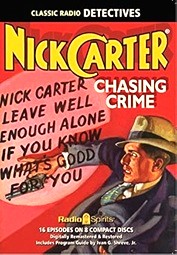
 Nick Carter, Master Detective (1943-1955) aired “The Case of the Missing Thumb” on May 4, 1947. We have showcased 18 previous Nick Carter episodes since 2009, this being the 2nd in almost 3 years, our last coming in May of last year, 2024. Carter’s history is long, covers numerous media, and is one of the more fascinating we’ve come upon. To crib from one of our earlier entries for new listeners, and slightly tweaked with new material, Nick Carter on radio ran a respectable twelve years, from 1943-1955, but the famous detective’s history begins much earlier. During the post-Civil War era known as Reconstruction, a short story featuring Carter appeared in an obscure fiction paper (The New York Weekly) in 1886 (predating the first Sherlock Holmes story by two years). The publisher was none other than Street & Smith, a fledgling, struggling publishing firm which would later become the most dominant pulp magazine publisher in the world. Among its later titles would be Astounding Science Fiction (now Analog), the only magazine from Street & Smith to survive the pulp magazine crash of the 1950s.
Nick Carter, Master Detective (1943-1955) aired “The Case of the Missing Thumb” on May 4, 1947. We have showcased 18 previous Nick Carter episodes since 2009, this being the 2nd in almost 3 years, our last coming in May of last year, 2024. Carter’s history is long, covers numerous media, and is one of the more fascinating we’ve come upon. To crib from one of our earlier entries for new listeners, and slightly tweaked with new material, Nick Carter on radio ran a respectable twelve years, from 1943-1955, but the famous detective’s history begins much earlier. During the post-Civil War era known as Reconstruction, a short story featuring Carter appeared in an obscure fiction paper (The New York Weekly) in 1886 (predating the first Sherlock Holmes story by two years). The publisher was none other than Street & Smith, a fledgling, struggling publishing firm which would later become the most dominant pulp magazine publisher in the world. Among its later titles would be Astounding Science Fiction (now Analog), the only magazine from Street & Smith to survive the pulp magazine crash of the 1950s.
Award-winning radio historian Elizabeth McLeod notes that, “Within a decade, an ongoing series of Nick Carter novels vaulted [Street & Smith] to the front ranks of dime-novel publishers, and made Nick himself a national institution. Nick’s own magazine, The New Nick Carter Weekly, would carry the detective into the twentieth-century.” By 1915, however, the then titled Nick Carter Weekly became Street and Smith’s Detective Story Magazine, a true pulp magazine and S&S’s initial entry into this new format. Again, from Elizabeth McLeod: “Detective Story Weekly soon became Street and Smith’s flagship publication. With the rise of radio in the 1920s, it became the firm’s entree into the broadcast medium. The Street and Smith Detective Story Hour became a favorite of listeners at decade’s end, with elaborate tales of murder and crime hosted by a mysterious narrator introduced only as “The Shadow.” While Nick Carter himself did not appear on the program, his spirit was very much in evidence in the various detective characters that populated the stories.” Of course, we all know what happened next. The mysterious voice only introducing the S&S Detective Story Hour became so popular that S&S launched The Shadow magazine in 1931, and shortly thereafter S&S added Doc Savage to its pulp adventure line. Amidst all of this activity Nick Carter was even given his own magazine (again) in 1933, proving the character’s resiliency and staying power—he was now 47 years old.
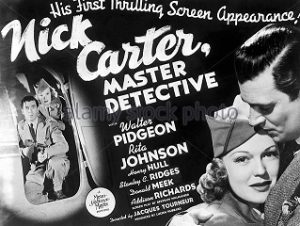
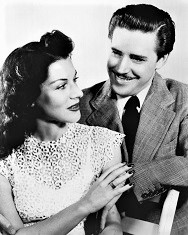 Nick Carter Magazine ran for 40 issues, from March 1933 to June 1936, the final six issues slightly retitled as Nick Carter Detective Magazine. While the magazine had folded, its long-running character still lived, for in 1939 Hollywood picked up the movie rights and produced three “B” Carter films starring noted actor Walter Pidgeon* (who later would star in the classic 1956 SF film Forbidden Planet). A mere three years later, Nick Carter would rise from the dead yet again in his own radio series, Nick Carter, Master Detective. The show’s producer and often the writer, Sherman “Jock” MacGregor, would enlist some of the best writers in the business to script Carter’s episodes, including Robert Arthur and David Kogan of Mysterious Traveler fame, the creator of The Shadow, Walter Gibson, and none other than legendary SF author and SFWA Grand Master Alfred Bester (one of which Bester-written episodes, “Chemical Chickens,” we ran in March of 2014 here). We are pleased to note that Bester (1913-1987, photo top right, 1976) wrote this week’s fine episode as well. Lon Clark played Nick Carter throughout its 12-year run, ably supported by first Helen Choate until mid-1945 and then Charlotte Manson (photo above right with Lon Clark) as Nick’s intelligent, perky secretary Patsy Bowen. Other mainstay characters included Police Sergeant Matty Mathieson, young newspaper reporter Scubby Wilson, and scruffy old veteran of the crime game Waldo McGlynn.
Nick Carter Magazine ran for 40 issues, from March 1933 to June 1936, the final six issues slightly retitled as Nick Carter Detective Magazine. While the magazine had folded, its long-running character still lived, for in 1939 Hollywood picked up the movie rights and produced three “B” Carter films starring noted actor Walter Pidgeon* (who later would star in the classic 1956 SF film Forbidden Planet). A mere three years later, Nick Carter would rise from the dead yet again in his own radio series, Nick Carter, Master Detective. The show’s producer and often the writer, Sherman “Jock” MacGregor, would enlist some of the best writers in the business to script Carter’s episodes, including Robert Arthur and David Kogan of Mysterious Traveler fame, the creator of The Shadow, Walter Gibson, and none other than legendary SF author and SFWA Grand Master Alfred Bester (one of which Bester-written episodes, “Chemical Chickens,” we ran in March of 2014 here). We are pleased to note that Bester (1913-1987, photo top right, 1976) wrote this week’s fine episode as well. Lon Clark played Nick Carter throughout its 12-year run, ably supported by first Helen Choate until mid-1945 and then Charlotte Manson (photo above right with Lon Clark) as Nick’s intelligent, perky secretary Patsy Bowen. Other mainstay characters included Police Sergeant Matty Mathieson, young newspaper reporter Scubby Wilson, and scruffy old veteran of the crime game Waldo McGlynn.
*(The first of the three Nick Carter films was 1939’s Nick Carter, Master Detective. Of interest to SF/F/H genre buffs is that it was directed by Jacques Tourneur, now famous for directing the following trio of Val Lewton horror films: Cat People (1943), I Walked with a Zombie (1943), and The Leopard Man (1943).)
From Nick Carter’s beginnings in 1886 through his final radio show in 1955, Carter would change with the times; from clean-living detective (actually, at the beginning of his career, Nick was a private investigator and consulting detective to the police department, much like Sherlock Holmes, and did not work as a police detective), master of disguise, to anti-espionage agent, to the bane of mad scientists or the defender of scientists beset by crooks, Nick Carter has enjoyed one of the longest surviving, most popular runs in various media for over 100 years, for when his radio show ended in 1955 he would resurface (yet again!) in a series of James Bond-type paperback novels in the 1960s which ran into the 1990s, quite a few of them written by women.
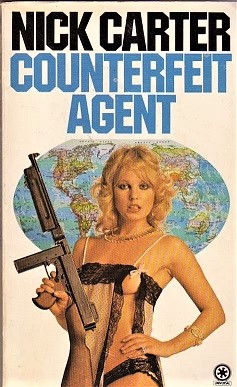
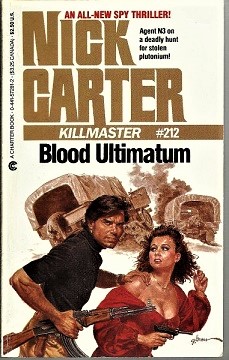
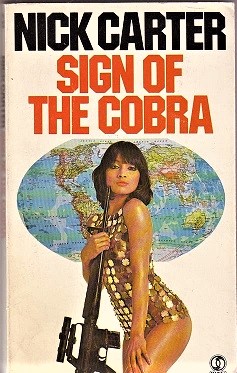
Virtually forgotten today, Nick Carter predates Dashiell Hammett’s Sam Spade, Raymond Chandler’s Philip Marlowe, and was originally inspired by the real-life exploits of private investigator Allan Pinkerton.
“The Case of the Missing Thumb” is a prime example of fiction mirroring reality, and even possibly foreshadowing it. Broadcast in early May of 1947, it has its starting point initially the same as the most famous example of film noir in Hollywood history. Out of the Past was released in late November of 1947 and starred Robert Mitchum and Jane Greer. Both this radio play and the film deal with an essentially good man trying to start over from a former life by working hard and living his life between the lines of right and wrong. And both are sidetracked by shadowy figures from their past who drag them unwillingly back into the life they have left behind. This is an effective hook to begin a mystery and is probably why it is used in both the radio and film scripts, but the plot device nevertheless invites comparison, though the storylines diverge appreciably after the initial conceit of the past catching up with someone who now leads a model life. But there are two other comparisons linking these stories, and the coincidences are remarkable. This radio episode is being posted on June 21, 2025. Exactly one week ago on June 14th the United States honored the 250th anniversary of the creation of its Army in 1775, with a gala military parade in Washington, DC. Much earlier that day, a few hours after midnight, a deranged soul impersonating a police officer shot and murdered a husband and wife and severely injured a second married couple in Minneapolis, MN. Imagine my surprise when a few days later I ran across this episode of Nick Carter, Master Detective where a young man has just returned from his service in the Army, is now a veteran, and his one dream is to be a detective like the renowned Nick Carter. Carter tries to dissuade this eager young man from following in his footsteps when a case comes along that changes his mind. There has been a robbery and murder at the United Veteran’s Incorporated business office, but what was stolen from the safe is unknown, so not only must the police apprehend the murderer but learn what the thief was after if not the $5,000 still in the safe. The story takes an ugly turn when it is discovered that an impostor dressed as a policeman has been involved, forcing Nick Carter and his young protegé into a heightened sense of urgency due to this alarming development. So in real life we have a parade for active and veteran members of the United States Army, while on the same day a murderer masquerades as a policeman. In this radio episode we have a recently discharged member of the army, and a murderer also masquerading as a policeman. What are the odds? Alfred Bester takes these elements and weaves them smartly into “The Case of the Missing Thumb,” an episode easily worth a listen.
(The linked CD at top includes this episode and 15 more, all digitally remastered and restored.)
Play Time: 26:58
{“The Case of the Missing Thumb” aired on a Sunday night in early May of 1947, which is all the impetus the neighborhood gang would need to launch them in the direction of the corner newsstand after the final school bell the next day. Crack Detective Stories (1938-1957) may not have been regarded as a top shelf entry in the detective magazine sweepstakes, but was able to attract and support a loyal enough core readership to last 20 years, despite 8 name changes. From November 1943 through September of 1949 it sported the Crack Detective Stories title and kept to its bimonthly schedule. Detective Tales (1935-1953) was a popular detective pulp (the 2nd most for its publisher, Popular Publications) that reliably held to its monthly schedule for all but the final 3 years of its 202 issue life. It was a monthly in 1947. Thrilling Mystery Novel (1935-1951) began as a magazine featuring the “weird menace” brand of story in an attempt to carve its own slice of the readership that had attracted fans to Terror Tales and others of its type of offbeat mystery, or with an outright horror influence. However, in the 1940s it gradually altered its emphasis to one of the more conventional sort of mystery adventure story and made its first of 4 title changes to Thrilling Mystery Novel in 1945. That said, when all was said and done, the original 1935 title of simply Thrilling Mystery would go through 4 name changes by its demise in 1951, its final title being 2 Detective Mystery Novels Magazine. Thrilling Mystery Novel Magazine managed 5 issues in 1947 while it switched from a bimonthly to a quarterly schedule with its last pair of issues.}
[Left: Crack Detective, 4/47 – Center: Detective Tales, 5/47 – Right: Thrilling Mystery Novel, 5/47]
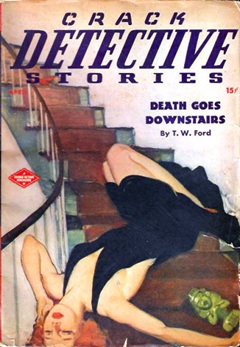

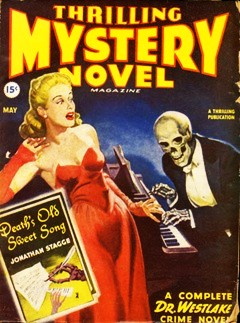
To view the entire list of weekly Old Time Radio episodes at Tangent Online, click here.